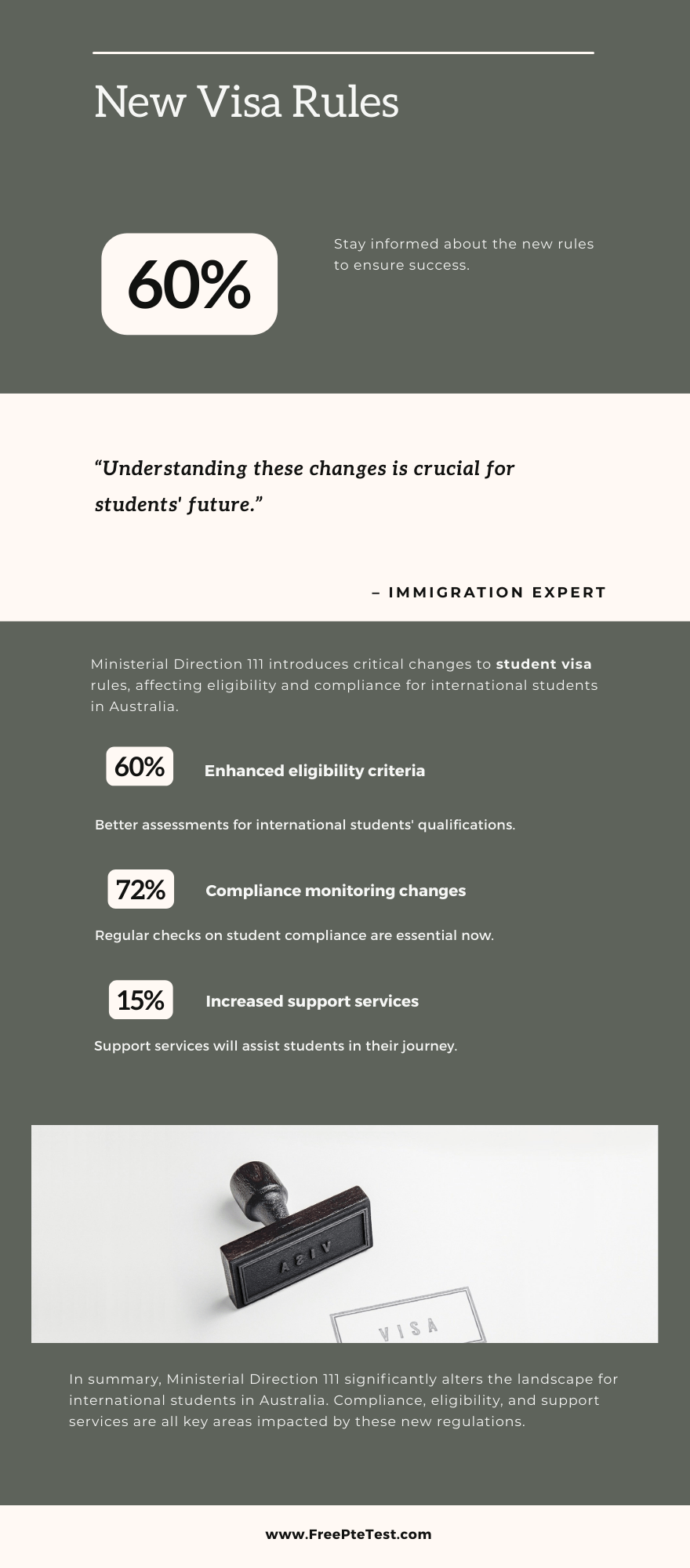New Rules for Australia Student Visa: As an expert in international education and Australian immigration policy, I recognize the critical importance of staying abreast of visa regulations for aspiring international students. The introduction of Ministerial Direction 111 (MD111) on December 19, 2024, marks a significant shift in how Australia processes offshore Student visa (Subclass 500) applications.
Replacing the contentious Ministerial Direction 107 (MD107), MD111 aims to create a fairer, more efficient, and transparent system for managing visa applications while supporting the sustainability of Australia’s international education sector.
This article provides a comprehensive overview of MD111, its implications, and practical guidance for students, enriched with examples and the latest updates from sources like freeptetest.com as of August 2025.
What is Ministerial Direction 111?
Ministerial Direction 111 (MD111) is a policy directive issued by the Australian Department of Home Affairs to guide the processing of offshore Student visa applications. Effective from December 19, 2024, it replaces MD107, which was criticized for disproportionately favouring larger institutions and disadvantaging regional and smaller education providers.
MD111 introduces a two-tiered prioritization system to ensure equitable access to visa processing across diverse providers while maintaining the integrity of Australia’s international education sector.
Key Features of MD111
- Revocation of MD107: MD107, implemented to manage high application volumes, was revoked on December 18, 2024, due to its uneven impact on providers, particularly regional institutions.
- Two-Tier Prioritization: MD111 categorizes applications into Priority 1 (High) and Priority 2 (Standard) based on the education provider’s 2025 New Overseas Student Commencements (NOSC) allocation, tracked via the Provider Registration and International Student Management System (PRISMS).
- No Hard Cap: Unlike the proposed National Planning Level (NPL) cap of 270,000 new commencements, MD111 does not impose a strict limit but uses the 80% NOSC threshold as a benchmark for prioritization.
- Stakeholder Engagement: Developed through consultations with the Department of Education and peak education bodies, MD111 ensures alignment with sector needs through webinars and ongoing communication.
Priority Processing Categories
- Priority 1 – High
- Eligibility: Applications from higher education and Vocational Education and Training (VET) providers that have not reached 80% of their 2025 NOSC allocation. Also includes school sector students, higher degree by research (HDR) candidates, scholarship recipients, Technical and Further Education (TAFE) students, and applicants from Pacific and Timor-Leste regions.
- Example: Priya, a nursing student applying to a regional TAFE in Queensland with 50% of its NOSC allocation used, benefits from Priority 1 processing, receiving her visa in under three weeks.
- Priority 2 – Standard
- Eligibility: Applications from providers that have exceeded their 80% NOSC threshold, subsequent entrants (e.g., family members), and other offshore applications.
- Example: Ahmed, applying to a metropolitan university that reached its 80% NOSC limit, faces standard processing times, taking up to six weeks for his visa approval.
Implications for Australia Student Visa
MD111 significantly impacts offshore students, visa applicants, and their families. Below, I outline its effects and provide actionable insights based on my expertise and real-world examples.
1. Enhanced Equity for Education Providers
MD111 addresses MD107’s bias toward larger institutions by prioritizing applications from providers with available NOSC allocations, particularly regional and smaller institutions. This levels the playing field for students choosing diverse study destinations.
- Example: Maria, an engineering student, chose a regional university in South Australia with a low NOSC allocation. Her Priority 1 application was processed in 18 days, compared to friends applying to oversubscribed metropolitan universities who waited longer.
2. Faster Processing for Priority 1 Applicants
Students applying to providers below the 80% NOSC threshold or in prioritized sectors (e.g., HDR, TAFE) benefit from expedited processing, often within 2–4 weeks, depending on application completeness.
- Example: John, a scholarship recipient from Fiji studying at an Australian TAFE, received his visa in 15 days due to his Priority 1 status under MD111.
3. Potential Delays for Priority 2 Applicants
Applications under Priority 2, including those from providers at or above their NOSC threshold or subsequent entrants, may face standard processing times of 4–8 weeks, depending on volume and complexity.
- Example: Clara, whose spouse applied as a subsequent entrant to join her at a Melbourne university, experienced a 5-week processing time for his Priority 2 visa, requiring careful travel planning.
4. Stricter Application Requirements
MD111 emphasizes complete and accurate applications to avoid delays. This aligns with broader 2025 visa reforms, including:
- Confirmation of Enrolment (CoE): Mandatory for all applications (onshore and offshore) from January 1, 2025, replacing Letters of Offer.
- English Language Proficiency: Minimum IELTS 6.0 (or equivalent, e.g., PTE 50, TOEFL iBT 78) for student visas, and IELTS 6.5 for Temporary Graduate visas. Tests must be taken in-person, with TOEFL iBT results valid only from May 5, 2024, onward.
- Financial Requirements: Applicants must demonstrate access to AUD 29,710 for living expenses, plus additional funds for partners (AUD 10,394) or children (AUD 4,449 per child).
- Genuine Student Requirement: Applicants must prove their intent to study and contribute to Australia’s skill needs, with increased scrutiny of course suitability and career goals.
- Example: Anil, a prospective IT student, was delayed because his initial application lacked a CoE. After resubmitting with complete documentation, his Priority 1 visa was approved in 20 days.
5. Impact on Subsequent Entrants
Family members (subsequent entrants) fall under Priority 2, potentially facing longer processing times. Early application is critical to align travel plans with the primary applicant.
- Example: Fatima’s family applied as subsequent entrants after her Priority 1 visa approval. Their Priority 2 applications took 6 weeks, requiring them to delay their move to Australia.

Broader 2025 Student Visa Updates
MD111 operates alongside other 2025 reforms to strengthen Australia’s international education system:
- Nomination Places Limit (NPL): Although the proposed 270,000 cap was not legislated, MD111 uses it as a benchmark, with 145,000 slots for higher education and 95,000 for VET.
- Increased Visa Fees: The application fee doubled to AUD 1,600, reflecting stricter scrutiny and administrative costs.
- Post-Study Work Opportunities: Graduates in skilled occupations may access the 4-year Skills in Demand Visa, enhancing pathways to permanent residency.
- Anti-Visa Hopping Measures: Restrictions prevent temporary visa holders from switching to student visas to extend stays, ensuring genuine student intent.
Recommendations for Prospective Students
To navigate MD111 and maximize your chances of timely visa approval, consider these expert tips:
- Apply Early: Submit your application at least 3–4 months before your course start date, especially for Priority 2 providers, to account for potential delays.
- Example: Priya applied in October 2024 for a February 2025 course, securing Priority 1 processing and avoiding last-minute stress.
- Choose Providers Strategically: Research providers’ NOSC status via PRISMS or consult education agents to select institutions with available allocations for Priority 1 processing.
- Example: John selected a regional VET provider with a low NOSC allocation, ensuring faster visa processing compared to a popular urban university.
- Ensure Complete Documentation: Include a valid CoE, proof of English proficiency (e.g., IELTS 6.0), financial evidence (AUD 29,710+), and a Genuine Student statement. Incomplete applications risk delays or rejection.
- Example: Anil’s second application succeeded after he included a CoE and a detailed statement linking his IT course to his career goals.
- Leverage Official Resources: Use freeptetest.com for OET preparation to meet English requirements, and check the Department of Home Affairs for updates on MD111 and visa policies.
- Engage Education Agents: Work with registered agents to navigate provider thresholds and application requirements, especially for complex cases like subsequent entrants.
- Example: Maria’s agent confirmed her university’s Priority 1 status, streamlining her application process.
- Monitor Application Status: Use your ImmiAccount to track progress and respond promptly to requests for additional information.
FAQs on Ministerial Direction 111 and 2025 Student Visa Rules
- What is the main change introduced by MD111?
MD111 replaces MD107 with a two-tiered system (Priority 1 and Priority 2) to prioritize offshore visa applications based on providers’ NOSC allocations, ensuring equity across institutions. - How does MD111 affect visa processing times?
Priority 1 applications (e.g., providers below 80% NOSC, HDR, TAFE) are processed faster (2–4 weeks), while Priority 2 may take 4–8 weeks. - What are the English language requirements for 2025?
A minimum IELTS 6.0 (or equivalent, e.g., PTE 50, TOEFL iBT 78) is required for student visas, and IELTS 6.5 for Temporary Graduate visas, taken in-person. - Is there an age limit for student visas?
No specific age limit exists, but younger applicants must demonstrate maturity and genuine study intent. - Can I appeal a visa rejection under MD111?
Yes, rejections can be appealed via the Administrative Appeals Tribunal, but strong documentation (e.g., CoE, financial proof) is crucial to avoid refusals. - How does MD111 impact family members?
Subsequent entrants (e.g., spouses, children) fall under Priority 2, potentially facing longer processing times. Apply early to align with the primary applicant’s travel.
Ministerial Direction 111, effective December 19, 2024, transforms Australia’s offshore Student visa processing by prioritizing equity, efficiency, and transparency. By categorizing applications into Priority 1 (faster processing for providers below 80% NOSC and specific sectors) and Priority 2 (standard processing), MD111 supports diverse education providers while maintaining rigorous standards.
Coupled with 2025 reforms like mandatory CoEs, stricter financial and English requirements, and anti-visa hopping measures, MD111 underscores Australia’s commitment to genuine students.
By applying early, choosing providers strategically, and ensuring complete documentation, you can navigate these changes effectively. Resources like freeptetest.com offer valuable tools for OET preparation to meet English proficiency requirements. With proactive planning, your journey to studying in Australia in 2025 can be both successful and rewarding.



